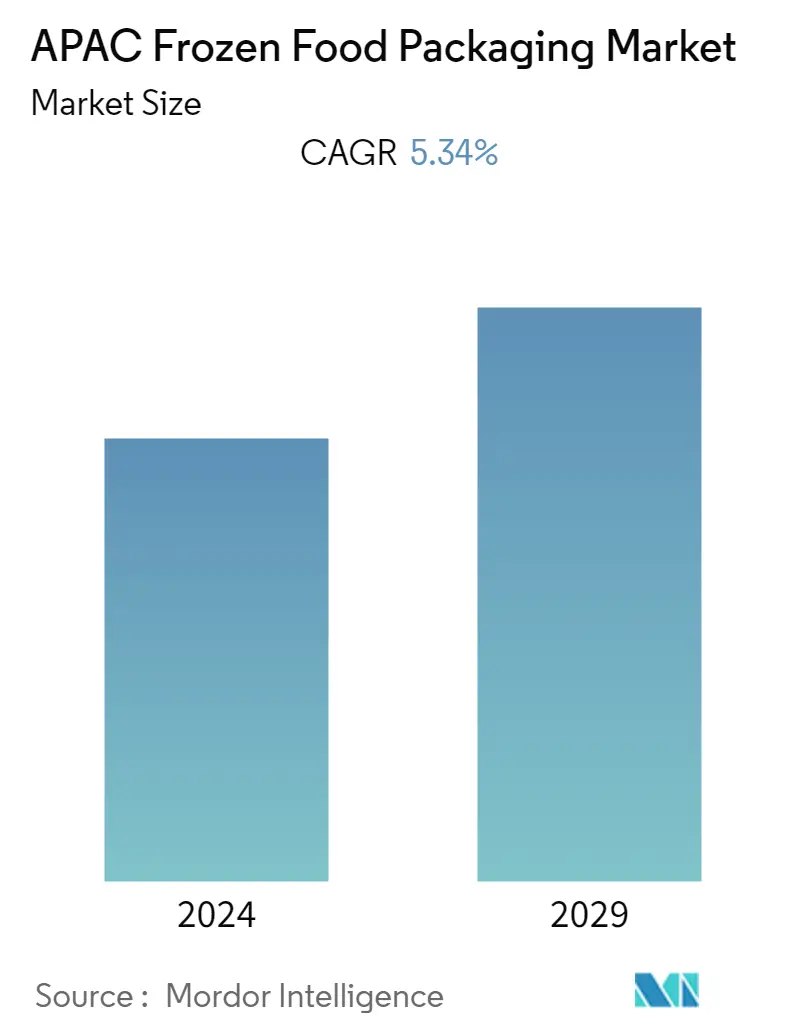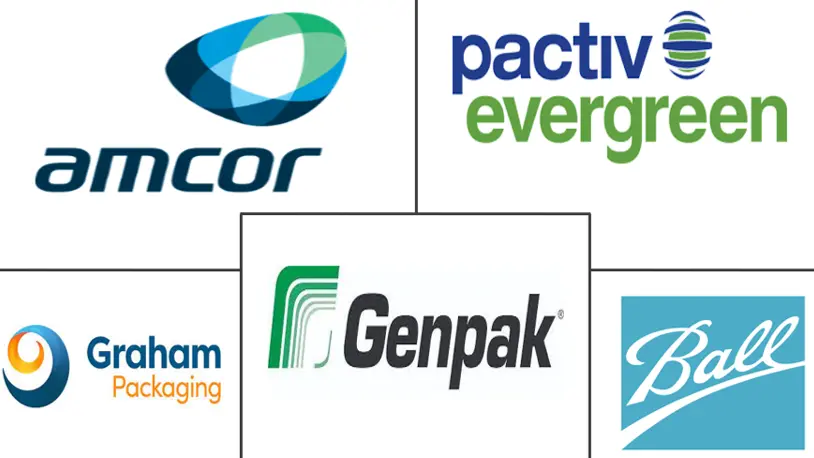Market Size of APAC Frozen Food Packaging Industry

| Study Period | 2019 - 2029 |
| Base Year For Estimation | 2023 |
| Forecast Data Period | 2024 - 2029 |
| Historical Data Period | 2019 - 2022 |
| CAGR | 5.34 % |
| Market Concentration | Medium |
Major Players
*Disclaimer: Major Players sorted in no particular order |
APAC Frozen Food Packaging Market Analysis
Asia Pacific Frozen Food Packaging Market will register a CAGR of 5.34% over the forecast period. The increasing demand for meat, seafood, fruits, and vegetables drives the market for frozen food packaging. Some of the emerging types in this sector are frozen ready-to-eat foods owing to lifestyle changes.
- The growing population in the Asia Pacific region is propelling the demand for food and frozen food products. Surging urbanization and expanding awareness about foodborne illnesses, food wastage, spoilage, quality products, and fast-paced lifestyle have shifted the preferences of consumers towards frozen food products, which requires less time for cooking than the traditional home-cooked meal.
- "On-the-go" customer base and rising purchasing power have further fueled the market through the growth in developing nations like China and India. The demand for frozen food packaging is also predicted to grow as there is a rising need for appealing, inventive, and easy-to-carry packaging to set the product apart from the competition.
- China has the largest share of the Asia-Pacific frozen food packaging market. According to the National Bureau of Statistics of China, 64.72% of the population resided in cities in 2021, contributing to the increased demand for frozen food products. Chinese consumers are now looking for easy-to-use and quality food products. The need for frozen meat and other regularly consumed products in the fixed food market has been constant in the region because of their availability.
- Players in the region are teaming up with private equity companies to expand their footprint in one of the nations with the highest rate of QSR development due to the rising ice cream consumption. It will spur demand for frozen food packaging. For instance, in May 2022, Dairy Queen, the prominent quick-service ice cream and fast food restaurant company, aimed to open 600 new restaurants in China by 2030, following an agreement with private equity firm FountainVest Partners to penetrate the country's frozen-treat market further.
- With the outbreak of COVID-19, frozen food packaging manufacturers got flooded with a pool of issues. However, they were only for the short -term. Some of the effects of the lockdown include supply chain disruptions, lack of availability of raw materials used in the manufacturing process, labor shortages, fluctuating prices that could cause the production of the final product to inflate and go beyond budget, shipping problems, etc.
- However, owing to the increased risk of diabetes as companies use starch to keep frozen food items fresh, the risk of heart disease and other diseases will hinder the market growth.
APAC Frozen Food Packaging Industry Segmentation
Frozen food packaging helps preserve food from when it is prepared to when the user will eat it. Frozen food packaging helps to maintain original color, flavor, and texture and generally more nutrients than foods preserved by other methods.
The market is segmented based on Primary material (Glass, Paper, Metal, Plastic), Type of food product (Readymade meals, Fruits and vegetables, Meat, Sea Food, Baked goods), and Type of packaging product (Bags, Boxes, Cans, Cartons, Trays, Wrappers), and Country. The market sizes and forecasts are in terms of value (USD million) for all the above segments.
| Primary Material | |
| Glass | |
| Paper | |
| Metal | |
| Plastic |
| Type of Packaging | |
| Bags | |
| Boxes | |
| Cans | |
| Cartons | |
| Trays | |
| Wrappers | |
| Other Packaging |
| Type of Food Product | |
| Readymade Meals | |
| Fruits and Vegetables | |
| Meat | |
| Sea Food | |
| Baked Goods | |
| Other Food Product |
| Geogrphy | |
| China | |
| Japan | |
| India | |
| Australia | |
| South Korea | |
| Rest of Asia-Pacific |
APAC Frozen Food Packaging Market Size Summary
The Asia Pacific frozen food packaging market is experiencing significant growth, driven by increasing demand for meat, seafood, fruits, and vegetables. This demand is further fueled by lifestyle changes that have led to a rise in frozen ready-to-eat foods. The region's growing population, coupled with urbanization and heightened awareness of foodborne illnesses, has shifted consumer preferences towards frozen food products, which offer convenience and reduced cooking time. The expanding "on-the-go" customer base and rising purchasing power in developing nations like China and India are also contributing to market expansion. The need for innovative and appealing packaging solutions is becoming increasingly important to differentiate products in a competitive landscape.
China holds the largest share of the market, with urbanization contributing to the increased demand for frozen food products. The country's consumers are seeking easy-to-use and high-quality food options, driving the need for effective packaging solutions. The market is also witnessing collaborations between regional players and private equity firms to expand their presence, particularly in the quick-service restaurant sector. Despite challenges posed by the COVID-19 pandemic, such as supply chain disruptions and labor shortages, the market is poised for growth. Factors like changing lifestyles, increasing disposable income, and the convenience of local retail establishments are further propelling the demand for frozen food packaging in the region.
APAC Frozen Food Packaging Market Size - Table of Contents
-
1. MARKET INSIGHTS
-
1.1 Market Overview
-
1.2 Value Chain / Supply Chain Analysis
-
1.3 Industry Attractiveness - Porter's Five Forces Analysis
-
1.3.1 Bargaining Power of Suppliers
-
1.3.2 Bargaining Power of Buyers
-
1.3.3 Threat of New Entrants
-
1.3.4 Threat of Substitute Products
-
1.3.5 Intensity of Competitive Rivalry
-
-
1.4 Assessment of the Impact of COVID-19 on the Market
-
1.5 Technology Overview
-
1.5.1 Technology Snapshot
-
1.5.2 Type of frozen food packaging products
-
1.5.3 Primary materials used for frozen food packaging
-
1.5.4 Ongoing developments
-
-
-
2. MARKET SEGMENTATION
-
2.1 Primary Material
-
2.1.1 Glass
-
2.1.2 Paper
-
2.1.3 Metal
-
2.1.4 Plastic
-
-
2.2 Type of Packaging
-
2.2.1 Bags
-
2.2.2 Boxes
-
2.2.3 Cans
-
2.2.4 Cartons
-
2.2.5 Trays
-
2.2.6 Wrappers
-
2.2.7 Other Packaging
-
-
2.3 Type of Food Product
-
2.3.1 Readymade Meals
-
2.3.2 Fruits and Vegetables
-
2.3.3 Meat
-
2.3.4 Sea Food
-
2.3.5 Baked Goods
-
2.3.6 Other Food Product
-
-
2.4 Geogrphy
-
2.4.1 China
-
2.4.2 Japan
-
2.4.3 India
-
2.4.4 Australia
-
2.4.5 South Korea
-
2.4.6 Rest of Asia-Pacific
-
-
APAC Frozen Food Packaging Market Size FAQs
What is the current APAC Frozen Food Packaging Market size?
The APAC Frozen Food Packaging Market is projected to register a CAGR of 5.34% during the forecast period (2024-2029)
Who are the key players in APAC Frozen Food Packaging Market?
Pactiv LLC, Amcor Ltd, Genpack LLC, Graham Packaging Company and Ball Corporation are the major companies operating in the APAC Frozen Food Packaging Market.

